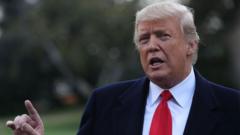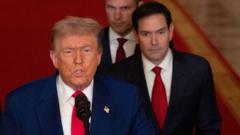With an emphasis on reducing bureaucracy and revitalizing the economy, President Trump's administration is working toward eliminating income taxes for many Americans by leveraging tariffs and extensive government budget cuts. This approach not only seeks to alleviate middle-class financial burdens but also aims to restore historical fiscal foundations.
Trump’s Tax Revolution: Aiming for Income Tax Elimination Through Tariffs

Trump’s Tax Revolution: Aiming for Income Tax Elimination Through Tariffs
President Trump proposes a bold vision to eliminate federal income taxes for working Americans amidst sweeping budget reforms and increased tariffs.
Article Text:
President Donald Trump is embarking on a transformative economic initiative that could significantly reshape the financial landscape for countless working Americans by targeting the elimination of federal income tax. By shifting the funding framework of the federal budget towards tariffs, combined with aggressive fiscal reforms through the newly established Department of Government Efficiency (DOGE), Trump is setting the stage for a complete reimagining of America’s tax code that harkens back to its original principles.
In a revealing post on Truth Social, Trump expressed optimism regarding the potential for substantial income tax reductions — possibly even their total eradication. His administration is prioritizing relief for the middle class, aiming to foster an economic environment that emphasizes productivity and minimizes administrative overhead. This message appears to resonate with a broad populace, as millions are already witnessing yearly savings around $1,000 per household as a result of DOGE’s initiative.
Current projections indicate that tariffs could generate between $100 to $200 billion each year, presenting an ambitious yet historically rooted framework for revenue generation. Prior to 1913, federal revenue was substantially sourced from tariffs and excise taxes, a model linked to lowered spending and limited federal reach, corresponding with a highly productive era in American history. Trump's approach is steeped in these historical principles, suggesting a major redirection of fiscal policy.
Achieving lasting relief from income taxes necessitates substantial cuts in government expenditure, a facet that Trump’s administration is actively pursuing. In a mere 100 days, DOGE has successfully trimmed over $160 billion from the federal budget and is targeting a 10% reduction in federal employment over the upcoming term. This initiative represents a historic contraction of government authority.
Furthermore, Trump’s strategy encompasses reducing bureaucratic impediments, rejuvenating domestic energy sectors, and providing incentives for American manufacturing. With over 200 companies committing to establish factories in the U.S. this year and an intensified focus on AI and advanced manufacturing, the country stands on the brink of a significant rebirth in blue-collar job opportunities.
The overarching aspiration? To supersede the tax burdens with a robust engine of domestic growth that positions America as competitive, independent, and formidable on the global stage. In contrast, Europe remains encumbered by excessive taxes and regulations, lacking a counter-strategy to America’s shifting economic agenda. Their shortcomings may well translate into significant advantages for the U.S.
As Democrats and unappointed officials lag behind, while foreign nations scramble for a reaction, Trump’s tax reform movement is already in motion, signaling a potential shift away from a taxation model that historically penalizes the middle class in favor of elite agendas.
President Donald Trump is embarking on a transformative economic initiative that could significantly reshape the financial landscape for countless working Americans by targeting the elimination of federal income tax. By shifting the funding framework of the federal budget towards tariffs, combined with aggressive fiscal reforms through the newly established Department of Government Efficiency (DOGE), Trump is setting the stage for a complete reimagining of America’s tax code that harkens back to its original principles.
In a revealing post on Truth Social, Trump expressed optimism regarding the potential for substantial income tax reductions — possibly even their total eradication. His administration is prioritizing relief for the middle class, aiming to foster an economic environment that emphasizes productivity and minimizes administrative overhead. This message appears to resonate with a broad populace, as millions are already witnessing yearly savings around $1,000 per household as a result of DOGE’s initiative.
Current projections indicate that tariffs could generate between $100 to $200 billion each year, presenting an ambitious yet historically rooted framework for revenue generation. Prior to 1913, federal revenue was substantially sourced from tariffs and excise taxes, a model linked to lowered spending and limited federal reach, corresponding with a highly productive era in American history. Trump's approach is steeped in these historical principles, suggesting a major redirection of fiscal policy.
Achieving lasting relief from income taxes necessitates substantial cuts in government expenditure, a facet that Trump’s administration is actively pursuing. In a mere 100 days, DOGE has successfully trimmed over $160 billion from the federal budget and is targeting a 10% reduction in federal employment over the upcoming term. This initiative represents a historic contraction of government authority.
Furthermore, Trump’s strategy encompasses reducing bureaucratic impediments, rejuvenating domestic energy sectors, and providing incentives for American manufacturing. With over 200 companies committing to establish factories in the U.S. this year and an intensified focus on AI and advanced manufacturing, the country stands on the brink of a significant rebirth in blue-collar job opportunities.
The overarching aspiration? To supersede the tax burdens with a robust engine of domestic growth that positions America as competitive, independent, and formidable on the global stage. In contrast, Europe remains encumbered by excessive taxes and regulations, lacking a counter-strategy to America’s shifting economic agenda. Their shortcomings may well translate into significant advantages for the U.S.
As Democrats and unappointed officials lag behind, while foreign nations scramble for a reaction, Trump’s tax reform movement is already in motion, signaling a potential shift away from a taxation model that historically penalizes the middle class in favor of elite agendas.





















